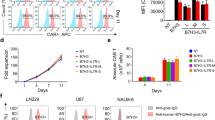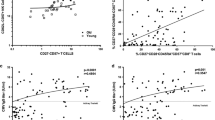Abstract
The activity of NF-κB/Rel transcription factors can inhibit the apoptosis induced by TNF, UV or cancer therapy drugs in a number of cell types, including human T lymphocytes. Furthermore, the NF-κB/Rel inducer, phorbol-12-myristate-13-acetate (PMA), has been reported to suppress the CD95-induced apoptosis of human T lymphocytes. To verify whether the survival-enhancing effect of PMA required NF-κB/Rel activity, we generated two Jurkat cell sublines (AL.7 and AL.8) transfected with a pCMV4-IκBα construct, and two (AL.3 and AL.5) with the void pCMV4 vector. Compared to wild type, AL.3 and AL.5 cells, the AL.7 and AL.8 sublines displayed markedly lower amounts of NF-κB/Rel nuclear complexes and a reduced expression of a κB-controlled CAT reporter gene after 1 and 4 h of incubation with PMA, respectively. All the five cell types displayed negligible levels of apoptosis when cultured with medium or PMA alone; when stimulated with the mAb CH-11, the AL.7 and AL.8 sublines displayed apoptotic responses only slightly (<0.5 fold) higher than control cells. On the other hand, the salvage activity of PMA was partially impaired in the AL.7 and AL.8 sublines. PMA inhibited apoptosis by >85% in wild type, AL.3 and AL.5 cells and by <60% in the AL.7 and AL.8 sublines; the apoptosis percentages in the mAb CH-11 + PMA cultures of the IκBα-transfected cells were >4-fold higher than in control cells. We conclude that the inhibition of the CD95-induced apoptosis by PMA relies on both NF-κB/Rel-dependent and -independent mechanisms. The partial contribution of these nuclear factors to the suppression of apoptosis indicates that the NF-κB/Rel activity can influence the extent of the CD95-induced T cell death.
Similar content being viewed by others
References
Lenardo MJ, Baltimore D. NF-κB: a pleiotropic mediator of inducible and tissue—specific gene control. Cell 1989; 58: 227-229.
Grilli M, Jason JS, Lenardo MJ. NF-κB and Rel: participants in a multiform transcriptional regulatory system. Int Rev Cytol 1993; 143: 1-62.
Bauerle P, Henkel T. Function and activation of NF-κB in the immune system. Annu Rev Immunol 1994; 12: 141-179.
Siebenlist U, Franzoso G, Brown K. Structure, regulation and function of NF-κB. Annu Rev Cell Biol 1994; 10: 405-455.
Miyamoto S, Verma I. Rel/NF-κB/IκB story. Adv Cancer Res 1995; 66: 255-292.
Baldwin Jr AS. The NF-κB and IκB proteins: new discoveries and insights. Annu Rev Immunol 1996; 14: 649-681.
Bauerle PA, Baltimore D. NF-κB: ten years after. Cell 1996; 87: 13-20.
Beg A, Baldwin A. The IκB proteins: multifunctional regulators of Rel/NF-κB transcription factors. Genes Dev 1993; 7: 2064-2070.
Gilmore T, Morin P. The IκB proteins: members of a multifunctional family. Trends Genet 1993; 9: 427-433.
Liou HC, Baltimore D. Regulation of the NF-κB/Rel transcription factor and IκB inhibitor system. Curr Opin Cell Biol 1993; 5: 477-487.
Sha WC, Liou HC, Tuomanen E, Baltimore D. Targeted disruption of the p50 subunit of NF-κ B leads to multifocal defects in immune responses. Cell 1995; 80: 321-330.
Weih F, Carrasco D, Durham SK, et al. Multiorgan inflammation and hematopoietic abnormalities in mice with targeted disruption of RelB, a member of the NF-κB/Rel family. Cell 1995; 80: 331-340.
Koentgen F, Grumont RJ, Strasser A, et al. Mice lacking the c-Rel protooncogene exhibit defects in lymphocyte proliferation, humoral immunity and interleukin-2 expression. Genes Dev 1995; 9: 1965-1977.
Beg AA, Sha WC, Bronson RT, Ghosh S, Baltimore D. Embryonic lethality and liver degeneration in mice lacking the RelA component of NF-κB. Nature 1995; 376: 167-170.
Abbadie C, Kabrun N, Bouali F, et al. High levels of c-Rel expression are associated with programmed cell death in the developing avian embryo and in bone marrow cells in vitro. Cell 1993; 75: 899-912.
Beg AA, Baltimore D. An essential role for NF-κB in preventing TNF-α-induced cell death. Science 1996; 274: 782-784.
Liu ZG, Hsu H, Goeddel DV, Garin M. Dissection of TNF receptor 1 effector functions: JNK activation is not linked to apoptosis while NF-κB activation prevents cell death. Cell 1996; 87: 565-576.
Van Antwerp DJ, Martin SJ, Kafri T, Green DR, Verma IM. Suppression of TNF-α-induced apoptosis by NF-κB. Science 1996; 274: 787-789.
Wang CY, Mayo MW, Baldwin AS. TNF-and cancer therapy-induced apoptosis: potentiation by inhibition of NF-κB. Science 1996; 274: 784-787.
Wu M, Lee H, Bellas RE, et al. Inhibition of NF-κB/Rel induces apoptosis of murine B cells. EMBO J 1996; 15: 4682-4690.
Romano MF, Lamberti A, Tassone P, et al. Triggering df CD40 antigen inhibits fludarabine-induced apoptosis in B chronic lymphocytic leukemia cells. Blood 1998; 92: 990-995.
Boothby MR, Mora AL, Scherer DC, Brockman JA, Ballard DW. Perturbation of the T lymphocyte lineage in transgenic mice expressing a constitutive repressor of nuclear factor (NF)-κB. J Exp Med 1997; 185: 1897-1907.
Nagata S, Golstein P. The Fas death factor. Science 1995; 267: 1449-1456.
Alderson MR, Tough TW, Davis-Smith T, et al. Fas ligand mediates activation-induced cell death in human T lymphocytes. J Exp Med 1995; 181: 71-77.
Brunner T, Mogil RJ, LaFace D, et al. Cell-autonomous Fas (CD95)/Fas-ligand interaction mediates activation-induced apoptosis in T-cell hybridomas. Nature 1995; 373: 441-444.
Critchfield JM, Boheme SA, Lenardo MG. The regulation of antigen-induced apoptosis in mature T lymphocytes. In Wiley-Liss ed, Apoptosis and the immune response 1995; 55.
Dhein J, Walczak H, Bäumler C, Debatin KM, Krammer P. Autocrine T-cell suicide mediated by APO-1/(Fas/CD95). Nature 1995; 373: 438-441.
Ju ST, Panka DJ, Cui H, et al. Fas (CD95)/FasL interactions required for programmed cell death after T cell activation. Nature 1995; 373: 444-448.
Abbas AK. Die and let live: eliminating dangerous lymphocytes. Cell 1996; 84: 655-657.
Rudert F, Wang Y, Lindridge E, Watson J. Apoptosis through CD95 (Fas/APO-1), but not a CD40/CD95 chimeric receptor, is inhibited by phorbol-12-myristate-13-acetate. DNA Cell Biol 1997; 16: 197-205.
Holmström TH, Chow SC, Elo I, et al. Suppression of Fas/APO-1-mediated apoptosis by mitogen-activated kinase signaling. J Immunol 1998; 160: 2626-2636.
DiDonato JA, Hayakawa M, Rothwarf DM, Zandi E, Karin M. A cytokine-responsive IκB kinase that activates the transcription factor NF-κB. Nature 1997; 388: 548-554.
Cann AJ, Koyanagi Y, Chen ISY. High efficiency transfection of primary human lymphocytes and studies of gene expression. Oncogene 1988; 3: 123-128.
Romano MF, Lamberti A, Petrella A, et al. IL-10 inhibits NF-κB/Rel nuclear activity in CD3-stimulated human peripheral T lymphocytes. J Immunol 1996; 156: 2119-2123.
Nicoletti I, Migliorati G, Pagliacci MC, Grignani F, Riccardi CA. A rapid and simple method for measuring thymocyte apoptosis by propidium iodide staining and flow cytometry. J Immunol Methods 1991; 139: 271-279.
Darzynkiewicz Z, Li X. Measurements of cell death by flow cytometry. In: Cotter TG and Martin SJ, eds. Techniques in Apoptosis, London: Portland Press, 1996: 71.
Vermes I, Haanen C, Steffens-Nakken H, Reutelingsperger C. A novel assay for apoptosis. Flow cytometric detection of phosphatidylserine expression on early apoptotic cells using fluorescein labelled annexin V. J Immunol Methods 1995; 184: 39-51.
Fadok VA, Voelker DR, Campbell PA, Cohen JJ, Bratton DL, Henson PM. Exposure of phosphatidylserine on the surface of apoptotic lymphocytes triggers specific recognition and removal by macrophages. J Immunol 1992; 148: 2207-2216.
Clément MV, Stamenkovic I. Superoxide anion is a natural inhibitor of Fas-mediated cell death. EMBO J 1996; 15: 216-225.
von Reyher U, Sträter J, Kittstein W, Gschwendt M, Krammer PH, Möller P. Colon carcinoma cells use different mechanisms to escape CD95-mediated apoptosis. Cancer Res 1998; 58: 526-534.
Wang CY, Mayo MW, Korneluk RG, Goeddel DV, Baldwin Jr AS. NF-κB antiapoptosis: induction of TRAF1 and TRAF2 and c-IAP1 and c-IAP2 to suppress caspase-8 activation. Science 1998; 281: 1680-1683.
Wallach D. Placing death under control. Nature 1997; 388: 123-125.
Van Antwerp DJ, Martin SJ, Verma IM, Green DR. Inhibition of TNF-induced apoptosis by NF-κB. Trends in Cell Biol 1998; 8: 107-111.
Duckett CS, Nava VE, Gedrich RW, et al. A conserved family of cellular genes related to the baculovirus iap gene and encoding apoptosis inhibitors. EMBO J 1996; 15: 2685-2694.
Chu ZL, McKinsey TA, Liu L, Gentry JJ, Malim MH, Ballard DW. Suppression of tumor necrosis factor-induced cell death by inhibitor of apoptosis c-IAP2 is under NF-κB control. Proc Natl Acad Sci USA 1997; 94: 10057-10062.
Opipari Jr AW, Hu HM, Yabkowitz R, Dixit VM. The A20 zinc finger protein protects cells from tumor necrosis factor cytotoxicity. J Biol Chem 1992; 267: 12424-12427.
Wu MX, Ao Z, Prasad KVS, Wu R, Schlossman SF. IEX-1L, an apoptosis inhibitor involved in NF-κB-mediated cell survival. Science 1988; 281: 47-50.
Ponton A, Clément MV, Stamenkovic I. The CD95 (APO-1/Fas) receptor activates NF-κB independently of its cytotoxic function. J Biol Chem 1996; 271: 8991-8995.
Ravi R, Bedi A, Fuchs EJ, Bedi A. CD95(Fas)-induced caspase-mediated proteolysis of NF-κB. Cancer Res 1998; 58: 882-886.
Wallach D, Boldin M, Varfolomeev E, Beyaert R, Vandenabeele P, Fiers W. Cell death induction by receptors of the TNF family: towards a molecular understanding. FEBS Letters 1997; 410: 96-106.
Author information
Authors and Affiliations
Rights and permissions
About this article
Cite this article
Lamberti, A., Romano, M.F., Agosti, V. et al. Regulation of cell survival in CD95-induced T cell apoptosis: role of NF-κB/Rel transcription factors. Apoptosis 4, 179–186 (1999). https://doi.org/10.1023/A:1009662606398
Issue Date:
DOI: https://doi.org/10.1023/A:1009662606398




